
|

![]()
Modern multi-speed bikes are marvels of technology, and allow a cyclist to select the gear ratio that will make the most efficient use of his/her energy. If you want to get the maximum possible speed/distance for the minimum effort (and there's nothing wrong with that!) you need a multi-speed bike...but, efficiency isn't everything!
If you're riding for sheer pleasure, or for exercise, you don't necessarily place that high a premium on output results, as measured in speed, distance or vertical climb. Instead, you may care more about the actual experience of riding your bike. In this case, you may be a candidate for a singlespeed bike.
Riding a singlespeed can help bring back the unfettered joy you experienced riding your bike as a child. You don't realize how much mental energy you devote to shifting until you relinquish your derailers, and discover that a whole corner of your brain that was formerly wondering when to shift is now free to enjoy your surroundings and sensations.
Paradoxically, a singlespeed is, in another sense, more efficient than a multispeed bike! While the single gear ratio will not be the "perfect" gear ratio for all conditions, in the conditions which fit the single gear, it is considerably more efficient mechanically than the drivetrain of a derailer bike.
A singlespeed bike dispenses with the weight of the derailers, shifters, cables, extra sprockets and longer chain. In addition, a singlespeed gear train runs the chain in a perfectly straight line from sprocket to chainwheel, and avoids the serpentine wind through the pulleys of a derailer. You can really feel the difference! A singlespeed is noticeably quicker and easier to pedal than a multispeed bike in the same gain ratio.
Singlespeed bikes are also considerably more sturdy and reliable than multispeed bikes. There's no derailer to bash if the bike falls over, catch on the underbrush or get overshifted into the spokes. The rear wheel itself is a lot stronger than one made with off-center (dished) spoking to make room for a whole bunch of sprockets on one side.
The one-speed revolution actually involves two different styles of bikes, singlespeeds and fixed gears. These are not the same thing, although they have much in common.
A fixed-gear bike differs in that it does not permit coasting: when the bike is rolling, the pedals will turn, just as with a child's tricycle. To enjoy the one-speed experience to the max, a fixed gear is the best choice if you ride mostly on pavement. A fixed gear gives a degree of control and one-ness with the bike that is not equaled by a freewheeling bike.
This site also contains several articles dealing with fixed-gear bikes.
Fixed gear is not ideal for all circumstances, however. A fixed gear is not well suited for seriously hilly terrain, and, more importantly, is not good for technical mountain biking. A mountain biker in difficult terrain must be able to control when each pedal is down, to avoid striking a pedal on rocks, logs or other obstructions. Similarly, jumping over obstacles is much more difficult on a fixed-gear bicycle. If your single gear is low enough for off-road climbing, it will be too low to spin on the descents.
You don't have to choose once and for all between fixed and freewheel, because the same bike can be both, if you use a reversible "flip-flop" hub.
Many cyclists interested in simplifying consider going to a singlespeed freewheel as a way to "test the waters" with the idea that if they turn out to like that, they might later convert to fixed gear.
This is generally the wrong way to approach it, in my opinion.
I STRONGLY recommend starting out with fixed gear. If it turns out to be a problem, you can easily convert to freewheel later if you want to...but my bet is you won't want to if you give fixed gear a good try (typically takes a couple of weeks of regular riding to get past the strangeness, but then it's quite addictive!)
Most folks who set up their bikes with a fixed/free flip-flop wind up using the fixed gear side pretty much all of the time. The freewheel option is mainly useful for when you have taken a longer-than-usual ride, and need to get home even though you're all tuckered out.
While coaster (backpedaling) brake bikes are also, mostly, single-speed machines, I don't recommend them for technical off-road use. Coaster-brake hubs have a good deal of internal friction, and coaster brakes have a number of serious drawbacks:
Short-reach caliper brakes and modern MTB rim brakes, either traditional cantilever or newer direct-pull styles can lock up either wheel at will, but also permit fine control over the modulation of each wheel's brake.
![]()
![]()
There are four ways you can go, as far as hubs are concerned. You can use a flip-flop hub, a multi-speed freewheel hub, a cassette hub, a single-speed BMX hub, or a single-speed MTB hub.
Flip-flop, or double-sided, hubs are threaded on both sides. Usually one side has a track-type threading, (with lockring) and the other side is threaded for a single-speed standard freewheel.
The usual way to use a flip-flop hub is to have a fixed gear on one side, and a single-speed freewheel on the other. The freewheel sprocket is larger than the fixed sprocket, providing a lower gear.
On an MTB, you use the fixed-gear side for most pavement riding, and save the freewheel for off-road use, or for getting you home when you are tired. Having the freewheel larger than the fixed sprocket gives you a lower gear when you are using the freewheel. This makes climbing easier. Since you can coast when you are using the freewheel, the lower gear is no disadvantage on the descents. See my separate article about this option.
Single-speed freewheels are commonly used on BMX bicycles: most shops that deal in BMX parts should stock them. The common size used for BMX is 16 tooth, but 17, 18, 20 and 22 tooth freewheels are available.
Note, there are two types of hubs called "flip-flop":
The cheapest way to convert a multi-speed bicycle into a singlespeed is to use the original rear hub, assuming that it is made for a conventional threaded freewheel. A single BMX freewheel will thread right on. Unfortunately, the chainline is likely to work only with your granny gear unless you re-space the rear axle and re-dish the wheel.
It is easy to convert a Shimano cassette Freehub ® for singlespeed use. The simplest way is just to remove the derailers, shorten the chain and thread it onto the chainwheel and rear sprocket of your choice. This is less than ideal, however, because you've got the extra weight of the unused sprockets to deal with, and the chainline will probably be crooked. The sprockets used on multi-speed cassettes are designed for easy shifting, which is not a good thing on a bike that isn't supposed to shift! The teeth are short, increasing the risk of cropping the chain.
The better way to convert a cassette Freehub ® is to remove the 7-, 8- or 9-speed cassette and replace it with a single sprocket. You will also need a bunch of spacer washers to hold the single sprocket in place. You can often get a suitable number of spacers by taking apart a couple of discarded, worn-out cassettes.
Having a single sprocket sandwiched in a stack of spacers makes it easy to get the sprocket properly aligned for perfect chainline with whichever chainwheel you choose to use in front.
You can use one of the old sprockets from your taken-apart cassette, but it you are less likely to have accidental derailment if you use sprockets made for single-gear us, with longer teeth. BMX cassette sprockets are best. These sprockets are quite inexpensive, and are available in a range of sizes.
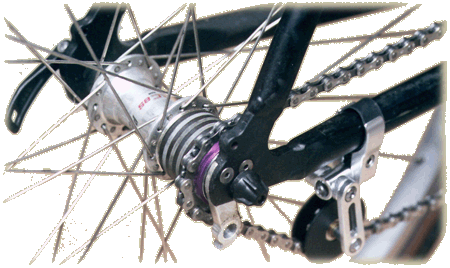
Disc brakes are increasingly popular for off-road use. They don't depend on good rim true, and don't get contaminated by mud. A number of high-end ready-made singlespeed bikes are supplied with front and rear disc brakes. In my opinion, this is not a good thing.
Personally I consider a rear disc brake a very poor choice for a singlespeed. It would preclude you from using a flip-flop hub. Also, as the chain wears and the axle is moved backward to take up the slack, the relationship of the disc to the caliper will change. That can't be good.
Singlespeeds are generally not practical for terrain so steep as to require dual disc brakes. There's no such problem with a front disc brake, but I strongly advise against getting a rear disc setup for a singlespeed. (There are different problems -- be aware of them. See information in the article on skewers and Jobst Brandt's article about brakes.)
Conventional wisdom is that you need a solid (nutted or "bolt-on") axle hub for fixed-gear or singlespeed use, and that a quick-release will not hold the wheel solidly enough in a horizontal forkend. This is not true, however.
Since most newer bikes have vertical dropouts, people have gotten used to wimpy aluminum skewers, and often don't adjust them as tightly as they might.
If you use a good quality (Shimano is the best) skewer, tightened securely, it will hold just fine in any type of dropout or forkend.
A quick release is a considerable timesaver in switching a flip-flop wheel around, and having a QR means that you don't need to carry a big wrench to be able to replace a damaged inner tube.
![]()
![]()
I have set up a couple of mountain bikes with flip-flop hubs, so that I get a singlespeed on one side and two different freewheel gears on the other. This is done with a double chainwheel and a two-speed freewheel. (The freewheel is actually an old 5- or 6-speed freewheel with 3 of the sprockets replaced by spacers).
this may also be done with a fixed gear on one side, and details of these setups are in the article about finxed-gear conversions on this site.
 ost newer bikes (made since the late-1980's) have "vertical" rear dropouts, where the wheel slides upward as you install it. These are a problem when you want to dispense with a derailer, because you need some way to regulate chain tension.
ost newer bikes (made since the late-1980's) have "vertical" rear dropouts, where the wheel slides upward as you install it. These are a problem when you want to dispense with a derailer, because you need some way to regulate chain tension.
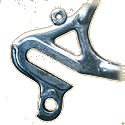 |
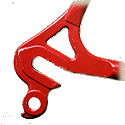 |
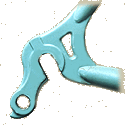 |
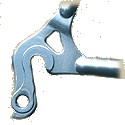 |
| Horizontal Dropout Campagnolo 1010 |
Horizontal Dropout Short |
Semi-Vertical Dropout | Vertical Dropout |
|---|---|---|---|
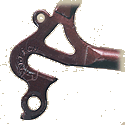 |
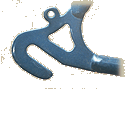 |
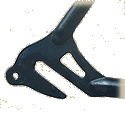 |
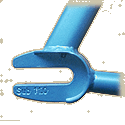 |
| With Hanger | Without Hanger | Raleigh 3-speed | Track Forkend Not a dropout! |
Most newer frames made for derailer use have vertical dropouts. This is convenient when you're actually using a derailer, but causes a complication when you wish to simplify your drive train, either to singlespeed, fixed-gear or an internal-geared hub. The simplest way around this is to install a chain-tensioning pulley of some sort. This is not an option for fixed gears or coaster brakes, but is the easiest solution for freewheeling bikes. Even for singlespeeds, though, it is nicer to be able to do without a klugy and inelegant chain tensioner. Options are described in our article about derailerless drivetrains.
Most mountain bikes have 135 mm spacing between the rear dropouts; most newer road bikes, 130 mm. Flip-flop ear hubs are commonly available in these spacings, although they are more commonly found in the narrower, 110-120 mm spacing which is standard for track hubs. If you are using a newer frame, with wider spacing, you may want to replace the axle. You may want to replace the axle in any case, because singlespeed hubs generally come only with solid axles, not quick release.
Gearing is a very personal matter, and it is difficult to give good specific recommendations for someone I haven't actually ridden with.
The best gearing for you depends on a large number of variables, including:
There is no magic formula for this, only experimentation will let you determine what gearing suits your needs.
You might find my online gear calculator useful for comparing with your present gearing.
Generally, for street use, with a freewheel, I would recommend a gain ratio of around 5-5.3, for instance, a 42 tooth chainring with a 16 or 17 tooth sprocket.
You'll see other sites recommending "2:1" gearing, which typically gives a gain ratio of about 3.7. That's good if you are going to be riding off road on steep mountain trails, but a gear that low is maddening on the flats and particularly on pavement, because your speed will be limited by the tendency to "spin out."
The same drive ratio may be achived with a larger or smaller chainwheel and rear sprocket, as long as the proportion is the same. You may read about the tradeoffs and other gearing issues in our article about derailerless drivetrains.
![]()
![]()
 erailer bikes can work fairly well even with the chain running at a considerable angle, but this should not be done with a singlespeed setup. It is quite important to get the chainline just right.
erailer bikes can work fairly well even with the chain running at a considerable angle, but this should not be done with a singlespeed setup. It is quite important to get the chainline just right.
You can check the chainline by installing the hub in the bike, with no chain installed. By placing your head just in front of the chainwheel, you can sight along the chainwheel and see back to the rear hub, to see if the chainwheel lines up exactly with the rear sprocket. If it doesn't, re-arrange spacers or change the bottom bracket axle as necessary. You might also hold a yardstick or other straightedge against the side of the chainwheel, reaching back to the sprockets.
There is detailed information on these topics in our article about derailerless drivetrains.
![]()
Unfortunately, singlespeed riding is somewhat of a fringe activity from a commercial point of view, and those who have not learned to love it tend to write singlespeeders off as nuts and fanatics.
If you have a local bike shop that stocks singlespeed stuff, you are in a lucky minority, and I urge you to patronize it.
If you don't have such a shop nearby, check out:
Singlespeed Parts from Harris Cyclery |
|---|
![]()
More information -- and, do you really need to coast? See also:
Sheldon Brown's Fixed Gear and Singlespeed Articles |
|---|
![]()
63xc.com-Fixed-gear Off road! |
|---|
Chain Life Extension |
Chainline |
Singlespeed Cyclocross by Tarik Saleh |
1 x 1 / Surly |
On One (UK) |
Paul Components |
SingleSpeed Drivetrains from Surly |
SingleSpeed World |
Spot |
![]()
![]()
As far as I know, this was the very first Web page ever about converting geared mountain bikes to singlespeed!